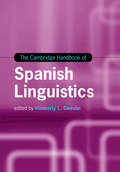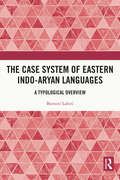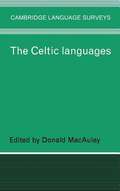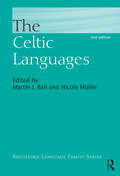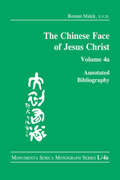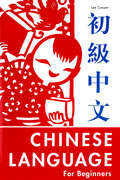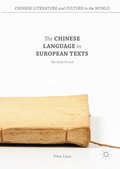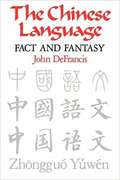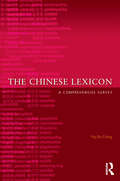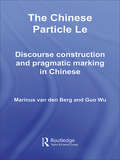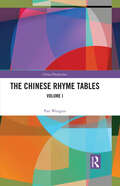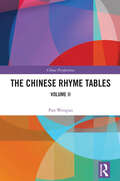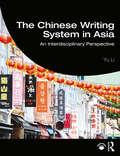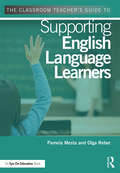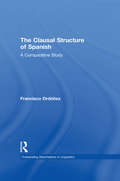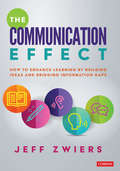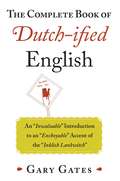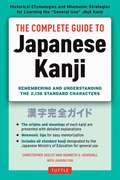- Table View
- List View
The Cambridge Handbook of Spanish Linguistics (Cambridge Handbooks in Language and Linguistics)
by Kimberly L. GeeslinA state-of-the-art, in-depth survey of the topics, approaches and theories in Spanish linguistics today. The language is researched from a number of different perspectives. This Handbook surveys the major advances and findings, with a special focus on recent accomplishments in the field. It provides an accurate and complete overview of research, as well as facilitating future directions. It encourages the reader to make connections between chapters and units, and promotes cross-theoretical dialogue. The contributions are by a wide range of specialists, writing on topics including corpus linguistics, phonology and phonetics, morphosyntax, pragmatics, the role of the speaker and speech context, language acquisition and grammaticalization. This is a must-have volume for researchers looking to contextualize their own research and for students seeking a one-stop resource on Spanish linguistics.
The Cambridge History of the Romance Languages
by Martin Maiden John Charles Smith Adam Ledgeway Martin Maiden John Charles SmithWhat is the origin of the Romance languages and how did they evolve? When and how did they become different from Latin, and from each other? Volume 2 of The Cambridge History of the Romance Languages offers fresh and original reflections on the principal questions and issues in the comparative external histories of the Romance languages. It is organised around the two key themes of influences and institutions, exploring the fundamental influence, of contact with and borrowing from, other languages (including Latin), and the cultural and institutional forces at work in the establishment of standard languages and norms of correctness. A perfect complement to the first volume, it offers an external history of the Romance languages combining data and theory to produce new and revealing perspectives on the shaping of the Romance languages.
The Cambridge History of the Romance Languages
by Martin Maiden John Charles Smith Adam Ledgeway Martin Maiden John Charles SmithWhat is the origin of the Romance languages and how did they evolve? When and how did they become different from Latin, and from each other? Volume 2 of The Cambridge History of the Romance Languages offers fresh and original reflections on the principal questions and issues in the comparative external histories of the Romance languages. It is organised around the two key themes of influences and institutions, exploring the fundamental influence, of contact with and borrowing from, other languages (including Latin), and the cultural and institutional forces at work in the establishment of standard languages and norms of correctness. A perfect complement to the first volume, it offers an external history of the Romance languages combining data and theory to produce new and revealing perspectives on the shaping of the Romance languages.
The Cambridge Old English Reader
by Richard MarsdenThis reader remains the only major new reader of Old English prose and verse in the past forty years. The second edition is extensively revised throughout, with the addition of a new 'Beginning Old English' section for newcomers to the Old English language, along with a new extract from Beowulf. The fifty-seven individual texts include established favourites such as The Battle of Maldon and Wulfstan's Sermon of the Wolf, as well as others not otherwise readily available, such as an extract from Apollonius of Tyre. Modern English glosses for every prose-passage and poem are provided on the same page as the text, along with extensive notes. A succinct reference grammar is appended, along with guides to pronunciation and to grammatical terminology. A comprehensive glossary lists and analyses all the Old English words that occur in the book. Headnotes to each of the six text sections, and to every individual text, establish their literary and historical contexts, and illustrate the rich cultural variety of Anglo-Saxon England. This second edition is an accessible and scholarly introduction to Old English.
The Case System of Eastern Indo-Aryan Languages: A Typological Overview
by Bornini LahiriThis book presents a typological overview of the case system of Eastern Indo-Aryan (EIA) languages. It utilizes a cognitive framework to analyse and compare the case markers of seven EIA languages: Angika, Asamiya, Bhojpuri, Bangla, Magahi, Maithili and Odia. The book introduces semantic maps, which have hitherto not been used for Indian languages, to plot the scope of different case markers and facilitate cross-linguistic comparison of these languages. It also offers a detailed questionnaire specially designed for fieldwork and data collection which will be extremely useful to researchers involved in the study of case. A unique look into the linguistic traditions of South Asia, the book will be indispensable to academicians, researchers, and students of language studies, linguistics, literature, cognitive science, psychology, language technologies and South Asian studies. It will also be useful for linguists, typologists, grammarians and those interested in the study of Indian languages.
The Celtic Languages
by Donald MacaulayThis volume describes the six modern Celtic languages. Four of these, Modern Irish, Scottish Gaelic, Welsh and Breton, are living community languages; the other two, Manx and Cornish, survived into the modern period, but are no longer extant as community languages, though they are the subject of enthusiastic revivals. The Celtic languages sets them briefly in their Indo-European context, and states their general relationships within the broader Celtic language family. Individual linguistic studies are first placed briefly in their sociolinguistic and sociohistorical context. A detailed synchronic account of each language then follows, including syntax, morphology, phonology, morphophonology, dialect variation and distribution. Each description is based on a common plan, thus facilitating comparison amongst the different languages. This latest volume in the Cambridge Language Surveys will be welcomed by all scholars of the Celtic languages, but has also been designed to be accessible to any reader with only a basic knowledge of linguistics. It is the only modern account to deal with all surviving Celtic languages in this detail.
The Celtic Languages: Readings In The Brythonic Languages, Festschrift For T. Arwyn Watkins (Routledge Language Family Series #68)
by Martin J. Ball Nicole MüllerThe Celtic Languages describes in depth all the Celtic languages from historical, structural and sociolinguistic perspectives with individual chapters on Irish, Scottish Gaelic, Manx, Welsh, Breton and Cornish. This second edition has been thoroughly revised to provide a comprehensive and up-to-date account of the modern Celtic languages and their current sociolinguistic status along with complete descriptions of the historical languages. This comprehensive volume is arranged in four parts. The first part offers a description of the typological aspects of the Celtic languages followed by a scene setting historical account of the emergence of these languages. Chapters devoted to Continental Celtic, Old and Middle Irish, and Old and Middle Welsh follow. Parts two and three are devoted to linguistic descriptions of the contemporary languages. Part two has chapters on Irish, Scots Gaelic and Manx, while Part three covers Welsh, Breton and Cornish. Part four is devoted to the sociolinguistic situation of the four contemporary Celtic languages and a final chapter describes the status of the two revived languages Cornish and Manx. With contributions from a variety of scholars of the highest reputation, The Celtic Languages continues to be an invaluable tool for both students and teachers of linguistics, especially those with an interest in typology, language universals and the unique sociolinguistic position which the Celtic languages occupy. Dr Martin J. Ball is Hawthorne-BoRSF Endowed Professor, and Director of the Hawthorne Research Center, at the University of Louisiana at Lafayette. Dr Ball has over 120 academic publications. Among his books are The Use of Welsh, Mutation in Welsh, and Welsh Phonetics. Dr Nicole Müller is Hawthorne-BoRSF Endowed Professor at the University of Louisiana at Lafayette. Among her books are Mutation in Welsh, and Agents in Early Irish and Early Welsh.
The Chinese Face of Jesus Christ: Annotated Bibliography: volume 4a (Monumenta Serica Monograph Ser.)
by Roman MalekThis volume provides an annotated bibliography of the Western and Chinese literature on Jesus Christ in China. It is a sequel to the interdisciplinary collection on the manifold faces and images of Jesus throughout Chinese history, from the Tang dynasty (618�907) to the present time.The present bibliography broadens and deepens the above-mentioned subject matter, and also points out aspects which have been addressed in the contributions and anthologies of the previous volumes of The Chinese Face of Jesus Christ, but which have not been treated thoroughly. Another aim of this bibliography is to initiate and enable further research, particularly in China. It includes bibliographical data from the beginning of the introduction of Christianity to China until the year 2013, occasionally also until 2014. A list of �Key References� enables the reader to identify important works on main topics related to Jesus Christ in China. Some examples of book covers and title pages are included in the section of �Illustrations.�Other volumes of the collection The Chinese Face of Jesus Christ are in preparation: Vol. 3c will present longer quotations from the sources listed in the present bibliography, Vol. 4b will contain a general index with glossary, and Vol. 5 will deal with the iconography of Jesus Christ in China.
The Chinese Language for Beginners
by Lee CooperA simple introduction to Chinese writing, pronunciation and intonation using short stories. Appropriate for all ages.Reading basic Chinese becomes simplified in this highly attractive and unusual manual designed for readers of all ages. Chinese writing, pronunciation, and vocabulary are described here in an entertaining and interesting manner to help beginners learn quickly. The author starts with simple characters and then combines these to make sentences and stories. This step-by-step process allows the reader to develop a basic knowledge of the complex Chinese language with maximum comprehension. A section dealing with pronunciation and intonation and a vocabulary list of the characters used in the book are included as an aid for he reader. Beautiful, imaginative Chinese characters, hand painted by a professional calligrapher and amusing illustrations by the author supplement the text and make learning to read Chinese fun along with fancy.
The Chinese Language for Beginners
by Lee CooperA simple introduction to Chinese writing, pronunciation and intonation using short stories. Appropriate for all ages.Reading basic Chinese becomes simplified in this highly attractive and unusual manual designed for readers of all ages. Chinese writing, pronunciation, and vocabulary are described here in an entertaining and interesting manner to help beginners learn quickly. The author starts with simple characters and then combines these to make sentences and stories. This step-by-step process allows the reader to develop a basic knowledge of the complex Chinese language with maximum comprehension. A section dealing with pronunciation and intonation and a vocabulary list of the characters used in the book are included as an aid for he reader. Beautiful, imaginative Chinese characters, hand painted by a professional calligrapher and amusing illustrations by the author supplement the text and make learning to read Chinese fun along with fancy.
The Chinese Language for Beginners
by Lee CooperA simple introduction to Chinese writing, pronunciation and intonation using short stories. Appropriate for all ages.Reading basic Chinese becomes simplified in this highly attractive and unusual manual designed for readers of all ages. Chinese writing, pronunciation, and vocabulary are described here in an entertaining and interesting manner to help beginners learn quickly. The author starts with simple characters and then combines these to make sentences and stories. This step-by-step process allows the reader to develop a basic knowledge of the complex Chinese language with maximum comprehension. A section dealing with pronunciation and intonation and a vocabulary list of the characters used in the book are included as an aid for he reader. Beautiful, imaginative Chinese characters, hand painted by a professional calligrapher and amusing illustrations by the author supplement the text and make learning to read Chinese fun along with fancy.
The Chinese Language in European Texts
by Dinu LucaThis detailed, chronological study investigates the rise of the European fascination with the Chinese language up to 1615. By meticulously investigating a wide range of primary sources, Dinu Luca identifies a rhetorical continuum uniting the land of the Seres, Cathay, and China in a tropology of silence, vision, and writing. Tracing the contours of this tropology, The Chinese Language in European Texts: The Early Period offers close readings of language-related contexts in works by classical authors, medieval travelers, and Renaissance cosmographers, as well as various merchants, wanderers, and missionaries, both notable and lesser-known. What emerges is a clear and comprehensive understanding of early European ideas about the Chinese language and writing system.
The Chinese Lexicon: A Comprehensive Survey
by Yip Po-ChingThe Chinese Lexicon is a detailed study of the words and word combinations used in modern Chinese. Yip Po-Ching defines the general properties of a language's lexicon, or vocabulary, prior to a thorough discussion of the organizational features of the Chinese lexicon. Comparisons are made between Chinese and English, highlighting the similarities and differences between the two lexicons. This fascinating work examines the relationships between word and meanings, and demonstrates the ability of language to combine continuity and change. It surpasses the scope of a dictionary and reveals the systematic nature of vocabulary. Features include: a wealth of language examples clear comparisons between Chinese and English Chinese characters and pinyin romanization throughout a comprehensive index. The Chinese Lexicon surpasses the scope of a dictionary and reveals the systematic nature of vocabulary. It will prove an invaluable resource for all students and teachers of Chinese.
The Chinese Particle Le: Discourse Construction and Pragmatic Marking in Chinese (Routledge Studies in Asian Linguistics)
by M.E. van den Berg G. WuEver since the start of Chinese linguistic studies, the description of the Chinese particle LE has remained elusive. The classification has evolved from a listing of sentences and the discussion of contrastive pairs to a more context and discourse-oriented analysis. The development in recent years of inferential models and situation semantics has opened the way for a renewed study of the use of the Chinese particle LE. This book discusses the Chinese data from a 'mental space' perspective and finally reveals the role so-called Chinese 'sentence LE' plays in the construction and maintenance of discourse.
The Chinese Rhyme Tables: Volume I (China Perspectives)
by Pan WenguoAs the first volume of a two-volume set that studies Chinese rhyme tables, this book focuses on their emergence, development, structure, and patterns. Rhyme tables are tabulated tool constituted by phonological properties, which helps indicate the pronunciation of sinograms or Chinese characters, marking a precise and systematic account of the Chinese phonological system. This volume first discusses the emergence of the model and factors that determined its formation and evolution, including the Chinese tradition of the rhyme dictionary and the introduction of Buddhist scripts. The second part analyzes the structure and arrangement patterns of rhyme tables in detail, giving insights into the nature of “division” (deng): the classification and differentiation of speech sounds, of vital significance in the reconstruction of middle Chinese. The author argues that deng has nothing to do with vowel aperture or other phonetic features but is a natural result of rhyme table arrangement. He also reexamines the principles for irregular cases (menfa rules) and categorizes the 20 rules into three types.The book will appeal to scholars and student studying linguistics, Chinese phonology, and Sinology.
The Chinese Rhyme Tables: Volume II (China Perspectives)
by Pan WenguoAs the second volume of a two-volume set that studies the Chinese rhyme tables, this book seeks to reconstruct the ancient rhyme tables based on the extant materials and findings. A rhyme table is a tabulated tool constituted by phonological properties, which helps indicate the pronunciation of sinograms or Chinese characters, marking an accurate and systematic account of the Chinese phonological system. The book first explores the relationship and identifies the prototype of the extant rhyme tables. Then the principles and methods for collating and rebuilding the ancient rhyme table are introduced. It then looks at the general layout, including tables, table order, shè, zhuǎn, rhyme heading, rhyme order, light and heavy articulations, rounded and unrounded articulations, and initials. The final chapter presents the reconstructed rhyme tables with detailed annotations and add-on indexes. The book will appeal to scholars and students studying Sinology, Chinese linguistics, and especially Chinese phonology.
The Chinese Writing System in Asia: An Interdisciplinary Perspective
by Yu LiThe Chinese Writing System in Asia: An Interdisciplinary Perspective integrates a diverse range of disciplinary approaches in examining how the Chinese script represents and actively shapes personal and social identities in and beyond Asia. It is an ideal read for students and scholars interested in a broad and culturally rich introduction to research on the Chinese writing system. It can also serve as the main text of an undergraduate course on the subject. Key features of this volume include: Insights from studies of the Chinese writing system in linguistics, script reform and technology, gender, identity, literature, and the visual arts; Examples embedded in inquiries of the cultural history and contemporary society of Asia; Rigorous yet accessible discussions of complex concepts and phenomena that assume no prior knowledge of Asian languages or linguistics; Supplementary multimedia materials and resources, including instructional support, available online.
The Classroom Teacher's Guide to Supporting English Language Learners
by Pamela Mesta Olga ReberThis book answers your key questions about educating English Language Learners (ELLs) and offers detailed guidance and concrete applications for your classroom. Designed as a one-stop-shop for classroom teachers of all grade levels and content areas, this book is chock full of essential information, delivered in a practical, concise format. In each chapter, you will find checklists, instructional strategies, tables, tools and ideas for next steps. The resources and examples provided are easy to implement and can be used the next day in your teaching. Topics addressed include: Getting to know your ELLs Considering how culture, language and academic background impact learning Bridging the home/school connection Pairing content and language objectives Gauging learner progress Collaborating with ELL staff Much more!
The Clausal Structure of Spanish: A Comparative Study (Outstanding Dissertations in Linguistics)
by Francisco OrdonezFirst Published in 2000. Routledge is an imprint of Taylor & Francis, an informa company.
The Communication Effect: How to Enhance Learning by Building Ideas and Bridging Information Gaps
by Jeff ZwiersThe &“communication effect&” is what happens when we saturate our classrooms with authentic communication, which occurs when students use language to build up ideas and do meaningful things. For starters, authentic communication deepens and increases language development, learning of content concepts and skills, rigor and engagement, empathy and understanding of others&’ perspectives, agency and ownership of core ideas across disciplines, and social and emotional skills for building strong relationships. And these are just the starters. With The Communication Effect, Dr. Jeff Zwiers challenges teachers in Grades 3 and up to focus less on breadth and more on depth by grounding instruction and assessment in authentic (rather than pseudo-) communication. This book provides: Ideas for cultivating classroom cultures in which authentic communication thrives Clear descriptions and examples of the three features of authentic communication: 1. building up key ideas (claims and concepts); 2. clarifying terms and supporting ideas; and 3. creating and filling information gaps Over 175 suggestions for using the three features of authentic communication to enhance twenty commonly used instructional activities across disciplines Additional examples of not-so-commonly-used activities that embody the three features Suggestions for improving four different types of teacher creativity needed to design effective lessons, activities, and assessments that maximize authentic communication Our students deserve to get the most out of each minute of each lesson. Authentic communication can help. As you read The Communication Effect and apply its ideas, you will see how much better equipped and inspired your students are to grow into the amazing and gifted people that they were meant to become.
The Communication Effect: How to Enhance Learning by Building Ideas and Bridging Information Gaps
by Jeff ZwiersThe &“communication effect&” is what happens when we saturate our classrooms with authentic communication, which occurs when students use language to build up ideas and do meaningful things. For starters, authentic communication deepens and increases language development, learning of content concepts and skills, rigor and engagement, empathy and understanding of others&’ perspectives, agency and ownership of core ideas across disciplines, and social and emotional skills for building strong relationships. And these are just the starters. With The Communication Effect, Dr. Jeff Zwiers challenges teachers in Grades 3 and up to focus less on breadth and more on depth by grounding instruction and assessment in authentic (rather than pseudo-) communication. This book provides: Ideas for cultivating classroom cultures in which authentic communication thrives Clear descriptions and examples of the three features of authentic communication: 1. building up key ideas (claims and concepts); 2. clarifying terms and supporting ideas; and 3. creating and filling information gaps Over 175 suggestions for using the three features of authentic communication to enhance twenty commonly used instructional activities across disciplines Additional examples of not-so-commonly-used activities that embody the three features Suggestions for improving four different types of teacher creativity needed to design effective lessons, activities, and assessments that maximize authentic communication Our students deserve to get the most out of each minute of each lesson. Authentic communication can help. As you read The Communication Effect and apply its ideas, you will see how much better equipped and inspired your students are to grow into the amazing and gifted people that they were meant to become.
The Complete Book of Dutch-ified English: An “Inwaluable” Introduction to an “Enchoyable” Accent of the “Inklish Lankwitch”
by Gary GatesHere is a book for anyone tired of speaking flat, colorless, homogenized English. Pennsylvania Dutchman Gary Gates provides a glossary, read-aloud section, songs, recipes, and more in this delightful, ?inwaluable” introduction to Dutch-ified English.Learn the meaning of ?rutch” and ?spritz,” what a ?clod” and a ?crotch” are, how to pronounce and make ?Cussin Rache’s Snitz and Knepp,” and what has happened to food when it’s ?all.” Spice up your vocabulary with delightful words and phrases, such as:? Grex: To complain, moan. ?Ah, quit your grexing, you have a vonderful life.”? Face: Belief, religious conwiction. ?Praise be! Rebecca has found her face in the Lord again!”? Gruntbecky: An expression of hard going. ?Gruntbecky! It’s difficult to run in this hot sun.”? Nix nootz: A devilish, mischievous person. ?Our daughter is a little nix nootz.”? Rupdawn: A massage. ?A good rupdawn will take the ache away.”Tired of trying to conform to traditional speech patterns, Gary offers a warm and funny celebration of the unique Dutch culture in America.
The Complete Guide to Japanese Kanji: Remembering and Understanding the 2,136 Standard Characters
by Kenneth G. Henshall Jiageng Fan Christopher SeelyLearn over 2,000 Japanese Kanji characters with this user-friendly Japanese language-learning book.This unique Kanji study guide provides a comprehensive introduction to all the Kanji characters on the Japanese Ministry of Education's official Joyo ("General Use") list-providing detailed notes on the historical development of each character as well as all information needed by students to read and write them. As fascinating as it is useful, this is the book every Japanese language learners keeps on his or her desk and visits over and over.This Kanji book includes: Clear, large-sized entries All of the General Use Joyo Kanji Characters Japanese readings and English meanings stroke-count stroke order usage examples mnemonic hints for easy memorization The components which make up each character are detailed and the Kanji are graded in difficulty according to Ministry of Education guidelines, allowing students to prioritize the order in which the Kanji are learned and track their progress. This book is essential to anyone who is planning to take the official Japanese Language Proficiency Test (JLPT) and will appeal to beginning students as well as those who wish to attain higher-level mastery of the Japanese language. It is the only book that also provides historical and etymological information about the Japanese Kanji.This latest edition has been updated to include all of the 2,136 Kanji on the expanded Joyo list issued by the Japanese government in 2010. Many entries have been revised to include the most recent research on character etymologies.
The Complete Guide to Japanese Kanji: Remembering and Understanding the 2,136 Standard Characters
by Kenneth G. Henshall Jiageng Fan Christopher SeelyLearn over 2,000 Japanese Kanji characters with this user-friendly Japanese language-learning book.This unique Kanji study guide provides a comprehensive introduction to all the Kanji characters on the Japanese Ministry of Education's official Joyo ("General Use") list-providing detailed notes on the historical development of each character as well as all information needed by students to read and write them. As fascinating as it is useful, this is the book every Japanese language learners keeps on his or her desk and visits over and over.This Kanji book includes: Clear, large-sized entries All of the General Use Joyo Kanji Characters Japanese readings and English meanings stroke-count stroke order usage examples mnemonic hints for easy memorization The components which make up each character are detailed and the Kanji are graded in difficulty according to Ministry of Education guidelines, allowing students to prioritize the order in which the Kanji are learned and track their progress. This book is essential to anyone who is planning to take the official Japanese Language Proficiency Test (JLPT) and will appeal to beginning students as well as those who wish to attain higher-level mastery of the Japanese language. It is the only book that also provides historical and etymological information about the Japanese Kanji.This latest edition has been updated to include all of the 2,136 Kanji on the expanded Joyo list issued by the Japanese government in 2010. Many entries have been revised to include the most recent research on character etymologies.
